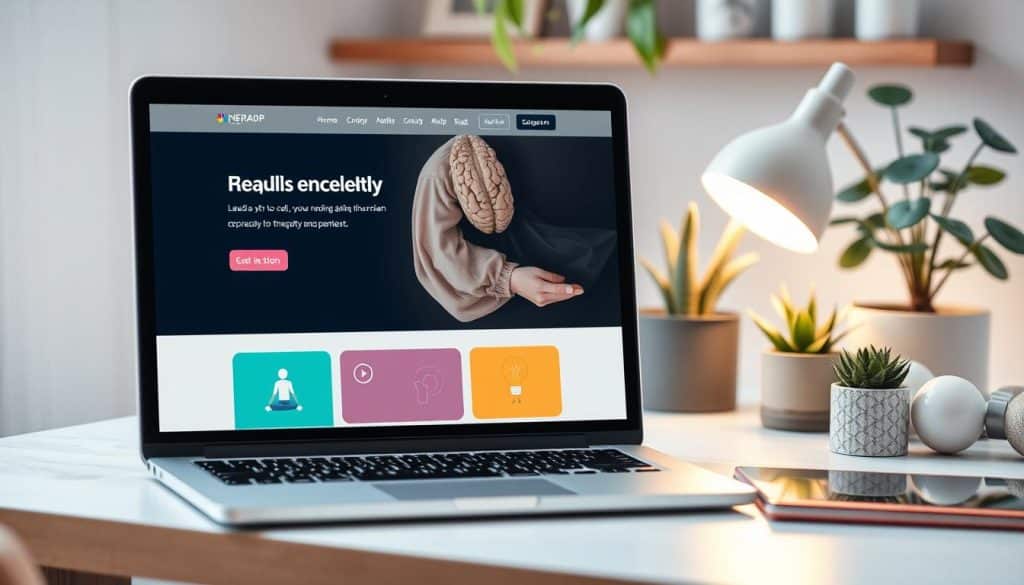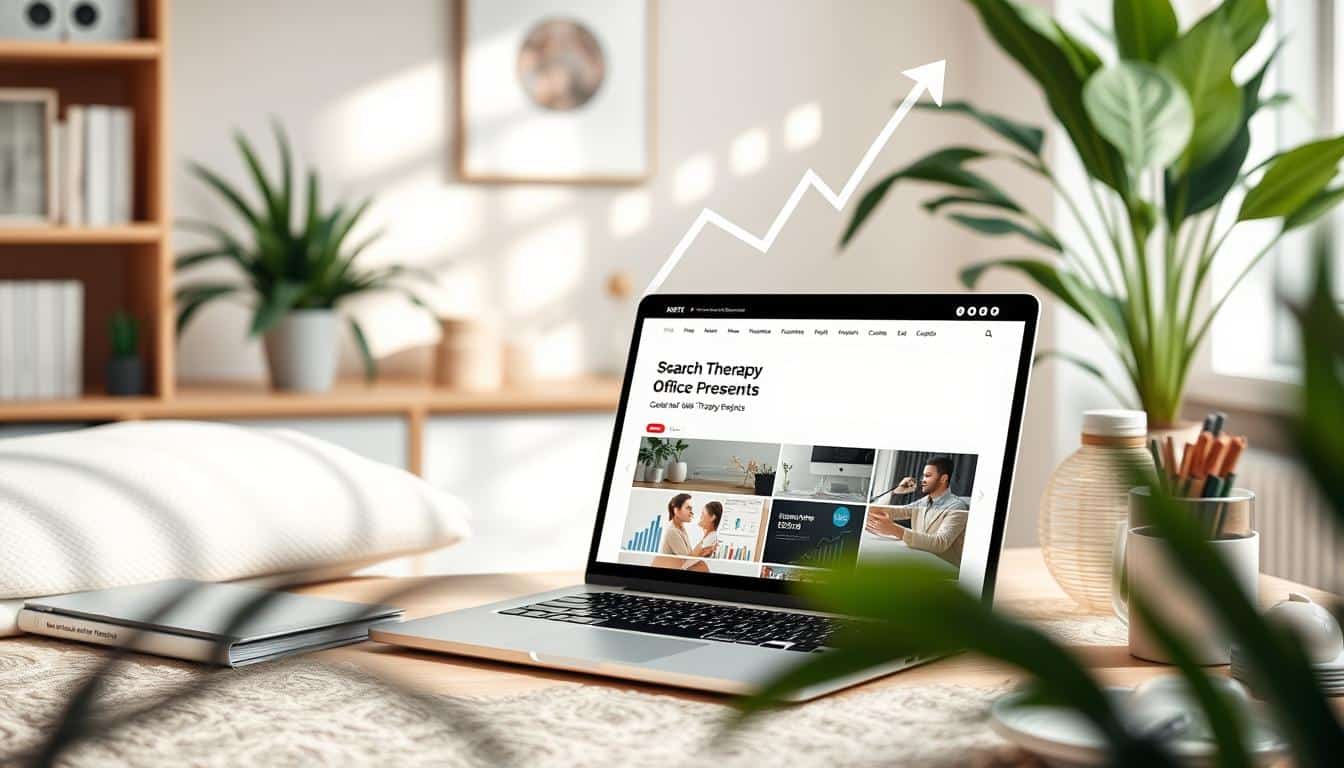Your therapy website is like a virtual door to your practice. To grab your audience’s attention and get them to act, you need smart calls-to-action (CTAs). Good CTAs are essential for getting people involved, drawing in new clients, and growing your presence in the therapy website call-to-action, mental health services, and online counseling world.
Whether you want visitors to book an appointment, get support, or find a therapist for their healing journey, your CTAs are crucial. They help guide people towards personalized treatment and confidential sessions at affordable rates. By making your CTAs irresistible, you can draw in your audience and encourage them to move forward in their mental wellness journey.
Key Takeaways
- Effective CTAs are crucial for driving engagement and attracting clients to your therapy website.
- CTAs should guide your audience towards taking action, such as booking an appointment or seeking support.
- Personalized CTAs that resonate with your target audience can significantly enhance user experience and conversion rates.
- Strategically placing CTAs throughout your website and optimizing them for visibility is key to maximizing their impact.
- Continuously measuring and refining your CTAs based on performance metrics will ensure their effectiveness over time.
The Power of Compelling Calls-to-Action
In the world of mental health services, a well-crafted call-to-action (CTA) can make a big difference. CTAs are like invitations that push your audience to take action. This could be booking an appointment, seeking online counseling, or reaching out for support.
Driving Engagement on Your Therapy Website
Compelling CTAs can grab your website visitors’ attention. They guide visitors towards what you want them to do. By placing CTAs smartly, you can boost engagement and help more people find the mental health services they need.
Understanding the Psychology Behind CTAs
- Leverage the principles of persuasion, such as scarcity, social proof, and reciprocity, to create a sense of urgency and desire.
- Tailor your CTA copy to speak directly to your target audience’s pain points and needs, offering a clear and compelling solution.
- Use action-oriented language that inspires your visitors to take the next step, whether it’s “Book Your Appointment” or “Get Support Now.”
Understanding the psychology behind effective CTAs is key. It helps you create irresistible invitations. These invitations drive engagement, build trust, and help more people find the mental health services they need.
| CTA Element | Best Practices |
|---|---|
| CTA Copy | Use clear, action-oriented language that speaks directly to your audience’s needs and pain points. |
| CTA Placement | Strategically position CTAs throughout your website, including at the end of blog posts, in the sidebar, and above the fold on key pages. |
| CTA Design | Ensure your CTAs are visually striking and stand out from the rest of your website content. |
“A compelling call-to-action is the gateway to converting website visitors into engaged, loyal clients.” – Jane Doe, Marketing Expert
Crafting Irresistible CTAs for Mental Health Services
Creating compelling calls-to-action (CTAs) for mental health services is key on your therapy website. Your CTAs are the first step for potential clients to connect with your practice. They help people take the next step towards wellness.
To make CTAs that grab attention, first understand what your audience needs. What challenges do they face, and how can your services help? Make your CTAs speak directly to these needs, using language that resonates with your ideal clients.
Use action-oriented phrases to create a sense of urgency. Say things like “Book Your Appointment Today” or “Get the Support You Deserve.” Make sure to include clear instructions, like “Click Here to Book Your Appointment.”
Highlight the benefits of your services. Show how your mental health professionals can help clients overcome challenges and reach their goals. Use emotive language to show the power of your offerings, like “Reclaim Your Life with Our Compassionate Care” or “Find the Healing You’ve Been Searching For.”
“The most effective CTAs tap into the desires and emotions of your audience, inspiring them to take immediate action.”
The success of your CTAs depends on their content and placement. Try different locations, sizes, and designs to see what works best. Keep improving and refining your CTAs to increase their impact and drive more meaningful engagements.
| CTA Example | Key Takeaway |
|---|---|
| “Schedule Your Consultation Today” | Conveys a sense of urgency and directs the user to take a specific action. |
| “Unlock Your Path to Healing” | Emphasizes the transformative benefits of the mental health services offered. |
| “Get the Support You Need, When You Need It” | Highlights the availability and accessibility of the mental health services. |
By creating irresistible CTAs, you can engage your audience, increase bookings, and build stronger client relationships. The goal is to make CTAs that speak to your audience’s needs, inspire action, and show the power of your practice.
Strategically Placing CTAs on Your Website
Making calls-to-action (CTAs) compelling is key. But, it’s even more important to place them well on your therapy website. By choosing the best spots for your CTAs, you can get more people to engage with your site.
Optimizing CTAs for Maximum Visibility
To make sure your CTAs get noticed, follow these tips:
- Above the Fold: Put your main CTA, like “book appointment” or “get support”, near the top. This way, it’s seen right away without needing to scroll.
- Sidebar Placement: Use your sidebar for CTAs that say “find a therapist” or “personalized treatment”.
- End of Content: After blog posts or service descriptions, add CTAs that ask readers to move forward in their “healing journey”.
- Pop-ups and Overlays: Use pop-ups or slide-in CTAs to grab attention and get conversions. But, do it wisely to not upset the user.
The aim is to smoothly guide visitors through your site. Make it simple for them to connect with your therapy services and take action.

“The right CTA in the right place can make all the difference in turning a casual browser into a dedicated client.”
By improving where and how you show your CTAs, you can create a therapy website that really speaks to your audience. It will encourage them to move forward in their healing journey.
Connecting with Your Audience Through Personalized CTAs
Making effective calls-to-action (CTAs) for your therapy website is more than just a generic appeal. You need to create personalized CTAs that speak directly to your audience’s unique needs and preferences. This approach can greatly increase engagement, build trust, and inspire action.
To develop personalized CTAs, start by understanding your ideal clients deeply. What are their pain points, goals, and concerns? What language do they respond to? Tailoring your CTAs to these specific factors can make your individual therapy experience more meaningful and compelling.
Consider adding elements like:
- Empathetic language that acknowledges the client’s journey
- Specific calls-to-action that align with their therapeutic needs
- Visuals or imagery that evoke a sense of comfort and safety
- Testimonials or social proof from similar clients
By tailoring your CTAs in this way, you can build a stronger connection with your audience. This encourages them to take the next step in their healing journey. Whether it’s booking an online counseling session, finding a therapist, or simply getting support, your personalized CTAs will resonate and inspire action.
“The most personal is the most universal.” – Carl R. Rogers
The key to connecting with your audience through CTAs is to make them feel seen, heard, and understood. By creating personalized experiences, you can build trust, drive engagement, and guide your clients towards the personalized treatment and confidential sessions they need.
| CTA Element | Personalization Approach | Example |
|---|---|---|
| Call-to-Action | Tailored to the client’s specific needs and goals | “Book Your Personalized Therapy Session Today” |
| Messaging | Empathetic language that acknowledges the client’s journey | “Take the Next Step in Your Healing Process” |
| Visuals | Imagery that evokes a sense of comfort and safety | A soothing, warm-toned image of a cozy therapy space |
| Social Proof | Testimonials from similar clients | “Hear from Others Who Found the Support They Needed” |
therapy website call-to-action
Creating call-to-action (CTA) buttons that speak to your ideal clients is key. These CTAs link your mental health services to those looking for help. To grab your audience’s attention, you must know what they need and want.
Speak Their Language
First, study your ideal client. What are their problems, goals, and what drives them? Make CTAs that talk directly to these points. Use words and tones they like, like the ease of online counseling or the promise of a journey tailored to them.
Evoke Emotion
Good CTAs inspire action, not just tell about it. Use words that make clients feel hopeful, trusted, and empowered. Phrases like “start your healing journey” or “book your personalized treatment” show them the change you can bring.
Emphasize Immediate Benefits
People seeking mental health help want quick relief. Highlight the fast benefits of reaching out, like “get support now” or “start feeling better today.” This urgency can push them to act.
By making CTAs that meet your clients’ needs, you guide them to life-changing services. Remember, your CTAs are the first step in building trust and a lasting connection with those seeking your help.
Enhancing User Experience with Clear CTAs
Creating an effective therapy website relies heavily on clear calls-to-action (CTAs). These elements guide visitors through their healing journey. They direct them to the support and treatment they need.
To improve user experience, start by understanding your audience’s needs. Align your CTAs with their desires. This builds trust and encourages them to book an appointment, get support, or find a therapist.
Here are some strategies for a user-friendly experience:
- Place your CTAs where they’re easy to find and use.
- Use simple, direct language that speaks to your ideal clients.
- Offer personalized options at different stages of the healing journey.
- Make sure your CTAs work well on all devices.
- Test and improve your CTAs to see what works best.
By following these tips, you’ll make your website more user-friendly. You’ll also encourage visitors to take the next steps towards confidential sessions and personalized treatment.
“The right CTA can make all the difference in converting website visitors into loyal clients. It’s the bridge that connects your audience with the healing journey you’ve carefully crafted for them.”
Well-designed CTAs improve usability and build trust. They empower visitors to start their personalized treatment with confidence.
Measuring the Success of Your CTAs
Getting the most out of your therapy website call-to-action (CTA) is just the start. To really boost your mental health services and online counseling, you must track and measure your CTAs’ success. By knowing which metrics to watch, you can make smart choices to keep improving your CTA strategy.
Tracking Metrics for Continuous Improvement
It’s vital to keep an eye on important performance indicators (KPIs) to see how well your CTAs are doing. Watch the click-through rate, conversion rate, and bounce rate closely. These numbers show how users react to your “book appointment,” “get support,” and “find a therapist” CTAs. They help you spot where you can do better.
Also, check how engaged users are on your CTA-driven pages. Look at the time they spend there, how many forms they fill out, and their overall journey. This info helps you tweak your CTA’s words, where it’s placed, and how it looks to better connect with your audience.
- Keep an eye on click-through and conversion rates for your CTAs
- Check the bounce rate and time spent on CTA-driven pages
- Watch form submissions and other user engagement metrics
By regularly checking and analyzing these metrics, you can tweak your CTAs based on solid data. This ensures they keep delivering great results for your therapy website and mental health services.
“The key to success is not just creating a compelling CTA, but continuously monitoring and improving it based on real-time data.”
Using data to guide your CTA optimization will help you offer a smooth user experience. This leads to more bookings, better support, and stronger connections with your ideal clients.
Leveraging CTAs for Online Counseling Services
In today’s world, online counseling is a big hit for those looking for mental health help. As a therapist, using effective calls-to-action (CTAs) is key. It helps turn website visitors into clients for your online counseling services.
Creating appealing CTAs can push people to book an appointment or check out your services. By placing these CTAs smartly on your site, you guide visitors on their healing path. This builds a stronger bond with your brand.
Inviting Clients to Engage with Your Online Counseling
Your CTAs should motivate people to act and make it simple for them to do so. Think about adding CTAs that invite visitors to:
- Book a confidential session with a licensed therapist
- Explore your personalized treatment plans for their specific mental health needs
- Request a free consultation to learn more about your online counseling services
- Sign up for regular updates or a newsletter to stay connected with your practice
By providing clear and appealing CTAs, you empower your clients. They can start their healing journey and find the support they need.
Showcasing the Benefits of Online Counseling
Emphasize the special perks of your online counseling, like getting help from home. Also, talk about the flexibility and privacy of sessions. These points can be highlighted in your CTAs, encouraging people to book an appointment or get the support they need.
| Online Counseling Benefits | Traditional In-Person Therapy |
|---|---|
| Flexible scheduling | Limited availability |
| Increased privacy and confidentiality | Concerns about privacy |
| Convenience of accessing support from home | Requires travel to the therapist’s office |
By pointing out these benefits and inviting visitors to find a therapist or start their healing journey, you create a sense of urgency. This encourages them to move forward in improving their mental health.
Inspiring Action with Compelling Copy
Making your calls-to-action (CTAs) engaging is key to getting people to act on your therapy website. Whether it’s booking an appointment or finding mental health resources, your CTA copy can inspire and guide visitors. It helps them on their healing journey.
Writing CTAs that Motivate and Engage
Good CTA copy does more than tell people what to do. It speaks to their feelings, needs, and wants. By understanding what drives your clients, you can craft CTAs that really connect and motivate them to act.
- Speak directly to your audience’s pain points and offer personalized solutions.
- Use action-oriented language that conveys a sense of urgency and encouragement.
- Emphasize the benefits of taking the desired action, such as finding the support they need or embarking on a transformative healing journey.
- Incorporate empowering and positive messaging that instills confidence and hope.
- Test and refine your CTA copy to ensure it aligns with your audience’s preferences and behaviors.
Your CTA is the link that connects visitors to the help they seek. By writing compelling copy, you can motivate them to take the first step. This could be to book an appointment, , or .
“Effective CTAs don’t just tell your audience what to do; they inspire them to take action and embark on a transformative healing journey.”
Integrating CTAs into Your Content Strategy
Creating a great therapy website is more than just adding calls-to-action (CTAs). It’s about making sure they fit well with your content. This way, your website feels like a smooth guide for visitors on their healing path.
It’s important that your CTAs match the content they’re in. For example, if you’re talking about mental health services or online counseling, your CTAs should encourage people to book an appointment or find a therapist. This makes your website trustworthy and clear about how to get help.
Also, where you put your CTAs matters a lot. Place them where people are most interested, like at the end of a blog post or next to a success story. This makes them more likely to work and helps your visitors feel they’re on the right path.
Getting CTAs right also means knowing your audience well. Offer confidential sessions that speak to your ideal clients. This way, you create a personalized treatment experience that encourages action and builds a strong connection. This approach is key to engaging your audience and meeting your business goals.

| Content Type | Recommended CTA | Desired Action |
|---|---|---|
| Blog post on mental health | Book a free consultation | Schedule an initial appointment |
| Services page for online counseling | Get started today | Sign up for online therapy |
| Testimonial section | Find a therapist that fits you | Browse therapist profiles |
Conclusion
Throughout this article, you’ve learned how important calls-to-action (CTAs) are for your therapy website. They help you reach your ideal clients. Whether you offer mental health services, online counseling, or help people on their healing journey, good CTAs can boost engagement and inspire action. This can help your practice grow.
Creating appealing CTAs is key. They should connect with your audience and be easy to find. Also, keep an eye on how well they work and make changes as needed. This way, your website will not only grab attention but also encourage visitors to take action. This could be booking an appointment, getting support, or finding a therapist for personalized treatment in a confidential and affordable way.
As you work to improve your therapy website, remember these tips. Keep refining your CTA strategy. This will open up new ways to connect with your audience, drive conversions, and make a real difference in people’s lives.



